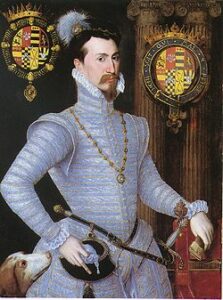 On this day in 1588, not long after England’s victory over the Spanish Armada, Robert Dudley, Earl of Leicester, died aged 56.
On this day in 1588, not long after England’s victory over the Spanish Armada, Robert Dudley, Earl of Leicester, died aged 56.
In her book “Elizabeth I”1, Anne Somerset writes of how Leicester’s health had been deteriorating for some time and that at the end of August 1588 Leicester set off for Buxton, Derbyshire, which was known for its healing baths of spa water. It was en-route to Buxton, at Rycote near Reading, a house which he had visited with Elizabeth, that Leicester wrote his last letter to his beloved Bess on the 29th August:-
“I most humbly beseech your Majesty to pardon your poor old servant to be thus bold in sending to know how my gracious lady doth, and what ease of her late pains she finds, being the chiefest thing in this world I do pray for, for her to have good health and long life. For my own poor case, I continue still your medicine and find that (it) amends much better than with any other thing that hath been given me. Thus hoping to find perfect cure at the bath, with the continuance of my wonted prayer for your Majesty’s most happy preservation, I humbly kiss your foot. From your old lodging at Rycote, this Thursday morning, ready to take on my Journey, by your Majesty’s most faithful and obedient servant,
R. Leicester
Even as I had writ thus much, I received Your Majesty’s token by Young Tracey.”2
This was the letter that Elizabeth I inscribed “His Last Letter” and treasured, keeping it in a box by her bedside where it was found after her death.
After writing this letter, Leicester continued his journey, stopping at Combury Park, near Woodstock in Oxfordshire, where his condition deteriorated until, at 4am on the 4th September, he passed away. He was buried in the Beauchamp Chapel of the Collegiate Church of St Mary’s in Warwick, the same place as his son, Robert Dudley, Lord Denbigh, who died in 1584 aged three. Leicester’s wife, Lettice (née Knollys), was buried alongside him after her death in 1634.
Elizabeth I was devastated by the death of the man she referred to as her “Eyes” or as “Sweet Robin”. They had known each other since childhood and I believe that he was the love of her life. Anne Somerset quotes an informant of Mendoza as reporting that “She was so grieved that for some days she shut herself in her chamber alone, and refused to speak to anyone until the Treasurer and other Councillors had the doors broken open and entered to see her”3 and Sir Francis Walsingham reported on the 7th September that it was impossible to do business with Elizabeth by “reason that she will not suffer anybody to [have] access unto her, being very much grieved with the death of the Lord Steward [Leicester].”4 Two months later, in November 1588, Elizabeth was described as “much aged and spent, and very melancholy” – Leicester’s death had hit her hard.
Jeane Westin, author of “His Last Letter: Elizabeth I and the Earl of Leicester”, brought me to tears with her moving scene in her prologue, when Elizabeth finds out that Leicester is dead:-
“She opened her mouth to shout down his lie, but at that moment came a great boom of cannon from the Tower and what the queen howled was neither heard nor understood by anyone in the presence chamber, least by herself. It was a cry of denial from the deepest well of her heart…
… She said something, but it was lost in a swift-moving red pain that filled her and became a sound… a name… Robin… my long love. How could I have forgotten you for a moment, even in my greatest triumph, our greatest triumph?
“Majesty, you should come away to your chambers. I would not have the court see you thus. A queen does not-”
“Does not!” she shrieked at her faithful advisor of thirty years and more. “Does not feel agony, does not… ” She lost the words spilling from her heart, if she had words instead of shrieks of disbelief. It could not be. Not Robin. He had promised never to leave her.”5
A beautifully written scene and it is impossible not to be moved by it.
Elizabeth did manage to pick herself up and do her duty as queen, but it is obvious that she never got over Leicester’s death. RIP Robert Dudley, Earl of Leicester.
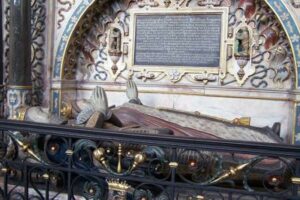
Notes and Sources
- Elizabeth I, Anne Somerset, p595-596
- His Last Letter, Jeane Westin, p360, Author’s Historical Note
- Somerset, p596
- Ibid.
- Westin, p9

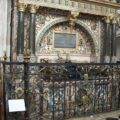

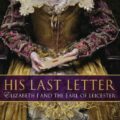




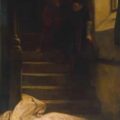
The love of Elizabeth I and Robert Dudley, Earl of Leicester, would not have near the appeal if they had married. Because they had no vows to one another on which to base their love, and had other commitments (her duties as Queen and his as husband) their story is even more poignant. I do believe that had they lived together as man and wife, their story would have devolved into the mundane, but because there was the resistance of the English populace and their other commitments, the “ordinary” joys of marriage were denied them and raised their love to a level few find today as caught up in the toils of lust as so many mistake for love today.
My daughter has been doing genealogy for some time, but just started on the Dudleys. My maternal grandfather’s name was Hugh Edward Dudley Sr. I am a direct decendant of Robert Dudley…fascinating ! Try as I might, I can’t stop researching the Dudley family. I just wish I had the funds to fly to England and visit our family castle. Now that would be just awesome! RIP Robert and Elizabeth.
I have been researching my family ancestors including the Butlers of Ireland (Sir Thomas Butler cousin of Elizabeth) and Admiral William Winter, head of the navy under Elizabeth I. In my search, I found the following: In the 1895 addition of the British Dictionary of National Biography Volume 16, page 114 under Dudley, it is reported that Queen Elizabeth was formally bethrothed to Dudley and that she was secretly married to him in the 2nd Lord Pembroke’s house in 1560, This was confirmed by 13th Earl of Pembroke when he provided a written document held in his monument room to Queen Victoria proving the secret marriage between Elizabeth and Dudley in 1560 and that she was pregnant by Dudley at the time.Victoria reportedly read the document and then put it on the fire, stating “One must not interfere with history.” This was reconfirmed by the 15th Earl of Pembroke to Andrew Lyell & emdash before Pembroke’s death in 1960. There is also evidence that Elizabeth and Dudley were the parents of Sir Francis Bacon in “Bacon’s Royal Parentage” by Francis Carr and Lawerence Gerald. The 2nd Lord Pembroke’s Aunt was Catherine Parr, Queen Consort and last wife of Henry VIII.
I am thrilled to have come across this website and to have heard about “His Last Letter” by Jeane Westin. I’ve just ordered it and can’t wait to read it while on the Plane from Arizona to London where me and my daughters will be visiting Dudley Castle, Kenilworth Castle & Warwick Castle. I’ve just begun researching my family history and am thrilled that Robert Dudley is part of my Ancestry. What a treat to have found this book just before our travels.To be able to stand on the same ground he did will be surreal and fantastic! Thank you!
Sleep well Robert my ancestor, for I am of the Ward family, we shall meet in the great hereafter someday.